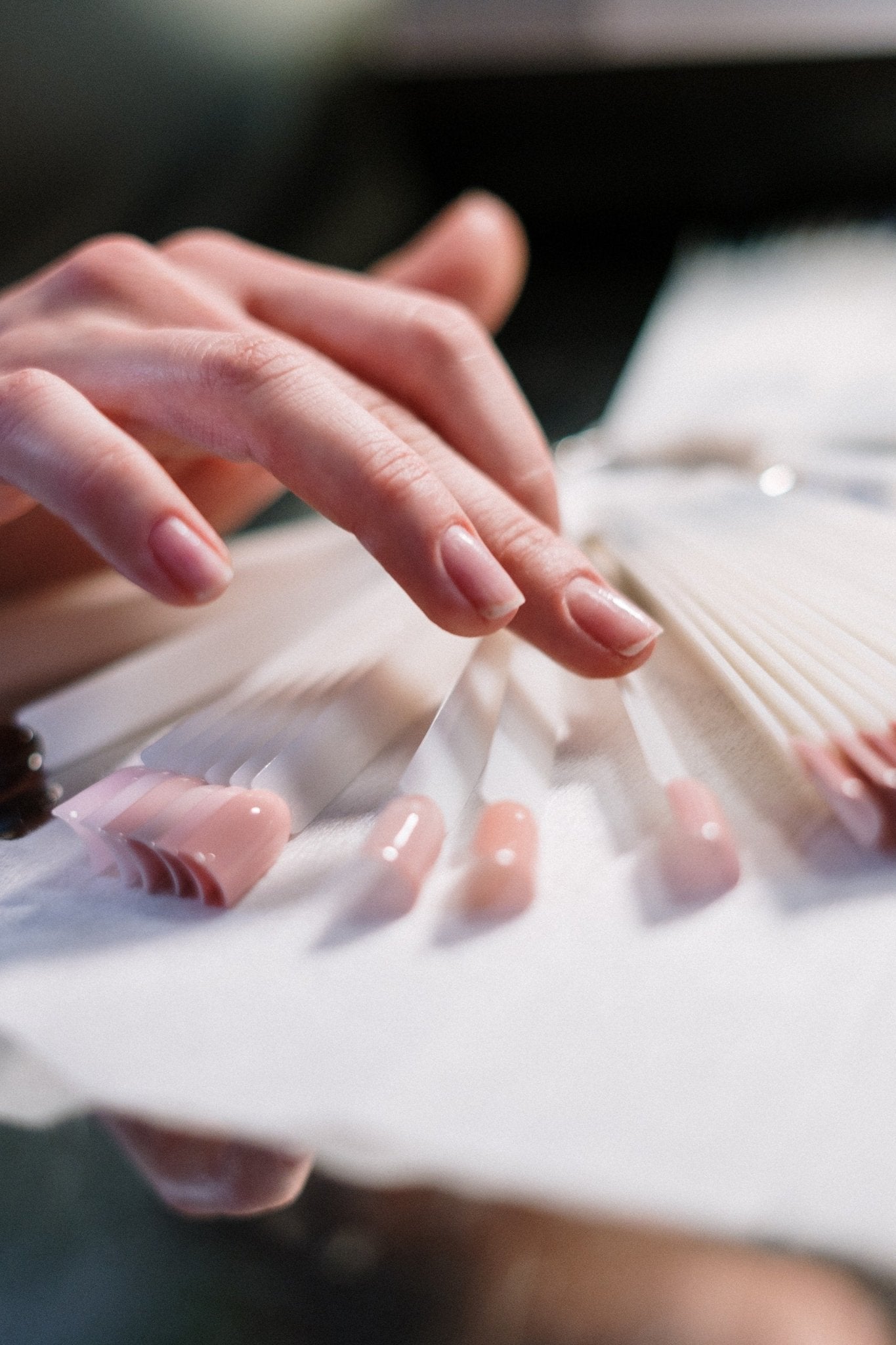They say the eyes are windows to the soul, but have you ever considered that your nails could be the windows to your health? Welcome to the Mersi Cosmetics blog, where we’re passionate about beauty, including maintaining healthy nails. Today, we're unveiling an insightful guide on what your nails say about your health.
Your nails can tell a tale about your well-being that you may often overlook. Nail abnormalities should not be disregarded as cosmetic concerns but as potential warning signs of underlying health conditions. Are they solid and shiny or brittle and discolored? The clues are literally at your fingertips. In this article, you'll discover how your nails are not just a canvas for the latest color trends but also vital indicators of your health status.
Let's dive into this fascinating topic as we unravel the secrets hiding beneath your manicure. Be prepared to view your nails in a whole new light!
Nails Provide Clues About Overall Health
Nails are composed of keratin, a protein found in the outer layers of our skin. They grow from the nail matrix beneath the cuticle, and various factors can influence their growth rate and appearance. Nail color, shape, and texture changes often indicate internal health issues.
By observing these changes, we can gain insights into potential problems affecting organs and systems within our bodies. Understanding the relationship between nail changes and health conditions can help us recognize the significance of these signs and take appropriate actions.
Description of Healthy Nails

Healthy nails exhibit specific characteristics as a baseline for assessing their overall health. Healthy nails are generally uniform, with a pinkish hue, and have a smooth surface without grooves or pits. The nails should be firmly attached to the nail bed and have a white crescent-shaped area called the lunula, located just above the cuticle.
Healthy nails should also have a moderate thickness and a smooth, rounded shape. Recognizing the appearance of healthy nails is essential for distinguishing abnormal changes.
Signs of Normal Nails
Color and Shape
Standard nail color varies slightly among individuals but is generally pinkish and translucent. The lunula, or the "little moon," should appear as a whitish semicircle at the base of the nail.
Texture and Lunula
Regarding texture, healthy nails are smooth and evenly shaped without deformities or irregularities. The surface should be relatively flat and not show any significant pitting, grooving, or ridges. Understanding the typical characteristics of nails allows us to identify deviations that may indicate underlying health conditions.
Nail Color Changes and Associated Health Conditions

White Nails
White nails, also known as leukonychia, can result from various causes. Leukonychia can be classified into two types: true leukonychia and apparent leukonychia. True leukonychia is characterized by white spots or lines on the nails and can be caused by trauma, nutritional deficiencies, liver disease, kidney disease, or heart failure. Apparent leukonychia occurs when the nail plate becomes opaque or white, often due to external factors such as nail polish or artificial nails.
In some cases, a condition known as Terry's nails may present with predominantly white nails with a narrow pink or red band at the tip. This condition can be associated with liver disease, kidney failure, congestive heart failure, or diabetes.
Yellow Nails
A 1964 study explains "yellow nail syndrome." This is where people's nails grow slower and take on a thickened, "piled-up" look. Yellow discoloration of the nails can occur for various reasons, including fungal infections, certain medications, and chronic smoking. Fungal infections, particularly onychomycosis, can cause the nails to become thickened, brittle, and yellow.
However, yellow nails can also indicate more serious underlying conditions such as psoriasis, thyroid disease, diabetes, lung disease, or even yellow nail syndrome.
Yellow nail syndrome is a rare condition characterized by slow-growing, thickened, curved yellow nails. It is associated with underlying respiratory disorders such as chronic bronchitis, bronchiectasis, pleural effusion, and lymphedema.
Bluish Nails
The appearance of bluish nails, also known as cyanosis, can indicate a lack of oxygen in the blood. This bluish tint is caused by light reflecting off deoxygenated blood vessels beneath the nail bed.
Cyanosis can be associated with various conditions, including respiratory problems like emphysema, chronic obstructive pulmonary disease (COPD), or pneumonia. It can also signify certain heart conditions, such as congenital heart defects, heart failure, or peripheral arterial disease. To treat this Cyanosis, you should apply nail polish that is breathable to make nails breathe oxygen. You can use Halal nail polish products like Clear Halal, Salar Halal, Rotomahana Halal and others at Mersi.
Nail Texture and Shape Changes as Indicators of Health

Rippled or Pitted Nails
Rippled or pitted nails can be early signs of dermatological conditions, particularly psoriasis and inflammatory arthritis. Psoriasis is an autoimmune disease that affects the skin, causing red, scaly patches.
When psoriasis affects the nails, it can result in irregular nail surface texture, including pitting, ridges, or nail plate separation. Similarly, inflammatory arthritis conditions such as rheumatoid arthritis and psoriatic arthritis can cause nail changes, including pitting and ridges. Our Ridge Filler is a great go-to option if you're looking to cure this.
Cracked or Split Nails
Dry, brittle nails that frequently crack or split can have multiple causes. One possible explanation is thyroid disease, which can affect nail health and lead to brittleness and dryness.
Another common cause is fungal nail infections, which can weaken the nail structure and make them prone to splitting and breaking. Other factors contributing to nail splitting include repeated exposure to water, chemicals, and aging.
Spoon Nails (Koilonychia)
Spoon nails, or koilonychia, refer to nails that appear scooped out or concave, resembling a spoon. This condition is associated with various underlying health issues. Iron deficiency anemia is one of the primary causes of koilonychia, as low iron levels can affect nail growth.
Hemochromatosis, a condition characterized by excessive iron absorption, can also result in spoon nails. Additionally, koilonychia may be observed in individuals with hypothyroidism or certain heart diseases.
Clubbed Nails
Clubbed nails present with an enlarged fingertip and a nail that curves downward, resembling a club. This nail deformity is often associated with conditions affecting the heart and lungs. Chronic respiratory conditions such as chronic obstructive pulmonary disease (COPD), bronchiectasis, or lung cancer can cause clubbing of the nails.
Similarly, heart conditions such as congenital heart defects, endocarditis, or heart failure can also lead to clubbing. In rare cases, clubbing may result from gastrointestinal disorders, including inflammatory bowel disease or liver cirrhosis.
Other Nail Abnormalities and Potential Health Conditions
Lines on the Nails
Dark-colored streaks or lines on the nails can raise concerns about melanoma, the most severe form of skin cancer. These streaks should not be ignored, as they indicate early melanoma development. If such lines appear, seeking prompt medical attention for proper evaluation and diagnosis is crucial.
Beau's lines are horizontal indentations or grooves that traverse the nail horizontally. These lines often occur due to an interruption in nail growth due to severe illness, injury, or systemic conditions such as uncontrolled diabetes, chemotherapy, or exposure to cold temperatures.
Nail Discoloration
Nail discoloration can be associated with various health conditions. As mentioned earlier, yellow nails can be linked to fungal infections, lung diseases, or systemic disorders. Terry's nails, characterized by predominantly white nails with a narrow pink or red band at the tip, can indicate liver disease, kidney failure, congestive heart failure, or diabetes.
Vertical brown streaks on the nails are common in individuals with dark skin tones but can also be seen in lighter skin tones.
Brittle Nails and Moisture
Brittle nails are a common issue, particularly as we age. This can be attributed to decreased moisture retention and decreased natural oil production in the nails. While some cases may be attributed to aging and environmental factors, brittle nails can also be linked to underlying health conditions such as thyroid disorders or nutritional deficiencies.
Moisturization is crucial in maintaining nail health and preventing brittleness and splitting. Protecting the nails with ring gloves when engaging in activities involving water or chemicals is also recommended. Proper nutrition, including a balanced diet with essential vitamins and minerals, can contribute to healthier nails. For nutrition purposes, Deep Nail Nutrition nail polish can be helpful.
When to Seek Medical Attention
It is essential to seek medical advice if nail changes persist or worsen over time. While some nail changes may be benign or related to external factors, persistent abnormalities can indicate underlying health conditions. Consulting a healthcare professional, such as a dermatologist or general practitioner, allows for proper evaluation, diagnosis, and appropriate management of potential health issues.
Accompanying symptoms should be noticed, as they can provide further insights into potential underlying health conditions. A healthcare professional should promptly evaluate symptoms such as fatigue, shortness of breath, abdominal pain, or other systemic manifestations. Timely assessment and diagnosis can lead to effective treatment and management of underlying conditions, promoting overall health and well-being. Although it is suggested to keep the nails hydrated, Almond Cuticle Oil nail polish is highly recommended.

Wrap Up
Our nails can serve as silent messengers, providing clues about our overall health. By paying attention to changes in nail color, shape, and texture, we can detect potential health conditions and seek appropriate medical attention. Recognizing the significance of these changes and their possible associations with various diseases allows us to take proactive steps to manage our health.
Nail health should be closely considered. By being aware of the typical characteristics of nails and recognizing changes that deviate from the norm, we can take a proactive approach to our health. Any persistent or concerning nail changes should be brought to the attention of healthcare professionals for proper evaluation and guidance. Maintaining nail health, such as practicing good nail hygiene and protecting nails from trauma and harsh chemicals, can contribute to overall well-being.
Frequently Asked Questions
Why do I have white spots on my nails?
White spots, or leukonychia, can appear on your nails due to minor injuries, nutritional deficiencies, or as an indication of more serious conditions like liver or kidney disease. If you consistently notice these spots, consider seeking medical attention.
What could be the cause of my yellow nails?
Yellow nails may result from a variety of factors, including fungalcolortions, the use of certain medications, or chronic smoking. They can also indicate more serious conditions like thyroid or lung disease. It's recommended to consult a doctor if you observe persistent yellow discoloration.
My nails have a rippled texture. What does this mean?
A rippled or pitted texture on your nails could be an early sign of dermatological conditions like psoriasis or inflammatory arthritis. If these symptoms persist, consider scheduling an appointment with a healthcare professional for evaluation.
My nails are brittle and frequently split. Should I be concerned?
Repeated brittleness and splitting can indicate underlying conditions such as thyroid disease or fungal infections. External factors like frequent exposure to water or chemicals and aging can also cause these symptoms. If you experience persistent nail brittleness, seeking medical advice is recommended.





Leave a comment
This site is protected by hCaptcha and the hCaptcha Privacy Policy and Terms of Service apply.